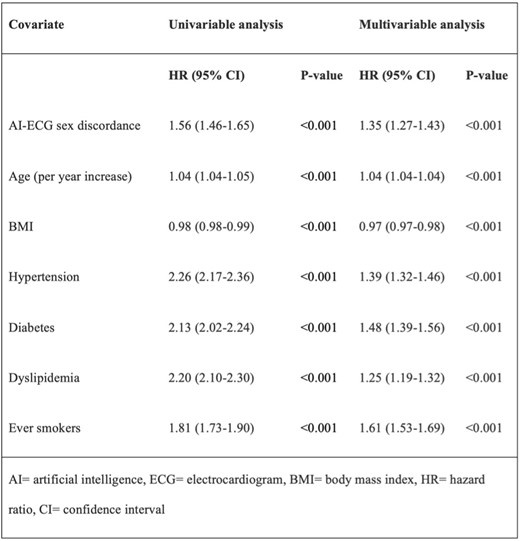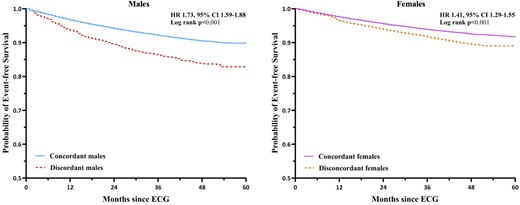-
PDF
- Split View
-
Views
-
Cite
Cite
G Multinu, N Rajai, I Ozcan, B Medina-Inojosa, J Medina-Inojosa, Z Attia, L O Lerman, F Lopez-Jimenez, P Friedman, A Lerman, AI-ECG sex-estimation discordances predict cardiovascular events, European Heart Journal, Volume 45, Issue Supplement_1, October 2024, ehae666.3481, https://doi.org/10.1093/eurheartj/ehae666.3481
Close - Share Icon Share
Abstract
Cardiovascular disease remains the leading cause of death and burden globally, warranting the need to explore novel predictors of major adverse cardiovascular events (MACE) using new technologies. Artificial Intelligence (AI)-enhanced ECG (AI-ECG) algorithms can provide information on cardiovascular health of individuals, independent of conventional risk factors.
The current study aimed to understand whether a previously described AI-ECG sex estimation algorithm could be applied for risk stratification of major adverse cardiovascular events (MACE), with a focus on a population without previous history of MACE.
Patients having 12-lead ECGs between 2018-2019 were included and followed up until August 2023. Exclusion criterion was a prior history of MACE. AI-ECG sex estimation was determined using a previously described algorithm predicting sex based on 12-lead ECGs. The algorithm generates outputs ranging from 0 to 1, representing the estimated probability of being male. Outputs above 0.5 were considered as AI-ECG-estimated male, and below as AI-ECG-estimated female. This was compared with biological sex to determine whether the two matched. Inconsistency between AI-ECG estimated sex and biological sex was defined as discordance. MACE was defined as myocardial infarction, coronary revascularization, non-fatal stroke, and all-cause death.
Among 80,578 subjects (mean age 59.1 ± 16.1 years, 52.4% female), 9.7% exhibited sex discordance in AI-ECG estimation. Discordance was associated with a 56% higher risk of MACE (HR, 1.56, 95% CI 1.46-1.65, p <0.001), and remained significant in multivariable analysis with traditional risk factors (HR 1.35, 95% CI 1.27-1.43, p <0.001) (Figure 1). Sex-specific analysis showed increased MACE risk in both discordant males and females (Figure 2).


Author notes
Funding Acknowledgements: None.



